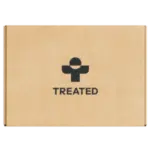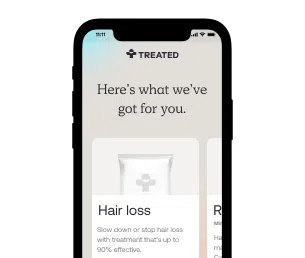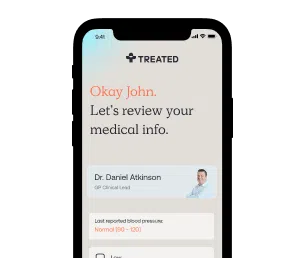Prurigo Nodularis
Topical treatments for inflamed, itchy skin.
Prurigo nodularis (PN) is an inflammatory skin condition that causes an itchy rash and small bumps. The itching is often intense, and can interfere with your sleep and daily life.
Our consultations are designed with your personal needs in mind. Get tailored recommendations and order prurigo nodularis treatments online.
Prurigo nodularis is a skin condition that causes itchy bumps to appear on your body. It usually affects your arms, legs, and upper back, although the bumps can appear anywhere.
The term prurigo is taken from ‘pruritis’, which is a medical term for itching. Nodularis refers to the small, hard bumps (nodules) that form as the condition develops.
The urge to scratch your skin when you have prurigo nodularis is often persistent because the itchiness it causes can be severe. Scratching your skin often makes things worse and can cause more inflammation. It can sometimes lead to an infection developing.
A clinician will usually ask some questions about your symptoms and to see photos of the affected skin before making an official diagnosis. You might then be advised to do some tests through your GP or at a clinic, because prurigo nodularis may be concurrent (occurring alongside) other diseases such as diabetes or hepatitis C.
Treatments for prurigo nodularis are often prescribed to soothe your itching skin, but managing the condition also involves reducing your urge to scratch the affected areas.
Prurigo nodularis can affect people of all ages, but it’s most common in those aged 20-60. There’s also evidence to suggest it occurs more frequently and more intensely in women.
A number of long-term diseases have been linked to risks of the rash developing. These include:
To rule out any of these conditions (along with others that might cause the itchy bumps to form), a clinician will usually ask you to have some blood tests done through your GP. Sometimes a skin scraping is performed so it can be examined under a microscope.
Because prurigo nodularis causes such a persistent urge to scratch, it commonly leads to physical and psychological distress. It can impact the moods, sleep, and general wellbeing of anyone who develops it, which means you’re at risk of developing anxiety and depression if your symptoms aren’t well managed.
Talk to a clinician if you feel like your rash is impacting your mental health.
A 2018 study of the prevalence of prurigo nodularis in England found that it’s quite rare. At the time of the study, 18,471 people in the country were living with it out of a population of around 56 million, so it’s fair to say it affects a relatively low number of people.
However, comorbidity (the presence of two or more diseases simultaneously) was high among this group, and included depression (41.1%), anxiety (35.4%) and dermatitis (52.2%).
While prurigo nodularis can be classed as uncommon, this study shows the impact the condition can have on people’s mental health and wellbeing. Finding the right treatment can reduce the psychological stress the rash can cause, while improving the symptoms of skin irritation and itchiness.

How we source info.
When we present you with stats, data, opinion or a consensus, we’ll tell you where this came from. And we’ll only present data as clinically reliable if it’s come from a reputable source, such as a state or government-funded health body, a peer-reviewed medical journal, or a recognised analytics or data body. Read more in our editorial policy.
It’s not fully understood what causes prurigo nodularis. Some people who develop it have another condition that makes their skin itchy to begin with, such as atopic dermatitis, end-stage kidney disease or allergies. There are lots of people who get itchy skin, though, that doesn’t develop into prurigo nodularis.
It might be hard to determine the initial cause of the condition, but constant scratching and itching can prolong the length of time you’re affected by a rash and uncomfortable bumps on your skin.
The most common symptom of prurigo nodularis is itching. As the skin disorder develops, hard bumps of skin (nodules) can start to appear as a result of scratching.
This ‘itch-scratch cycle’ plays a significant role in the development of the condition, and it’s not fully understood to what extent the bumps occur naturally, or appear because of constant irritation to the skin caused by scratching.
The nodules can appear to be:
Sometimes, as a result of constant itching that doesn’t allow the bumps to heal properly, scars can form.

How we source info.
When we present you with stats, data, opinion or a consensus, we’ll tell you where this came from. And we’ll only present data as clinically reliable if it’s come from a reputable source, such as a state or government-funded health body, a peer-reviewed medical journal, or a recognised analytics or data body. Read more in our editorial policy.
Treatments for prurigo nodularis are used to both reduce inflammation and ease itchiness. This is so the cycle of itching and scratching the skin can be broken, and allow the irritated skin to heal properly.
Steroid creams that contain betamethasone are often prescribed to treat swollen and irritated skin. It might be prescribed if a clinician thinks it can help reduce your prurigo nodularis symptoms.
Antimicrobial cleansers such as HibiScrub can disinfect your skin, and prevent infections caused by scratching. It works by forming a layer on your skin that acts as a barrier to prevent further damage.
Antihistamines, such as loratadine or cetirizine, can also help with itchiness.
There are a range of skincare treatments available over the counter. These include creams, ointments and moisturisers. Emollients (such as E45) that soothe and hydrate your skin might offer some relief from your prurigo nodularis symptoms if they reduce your urges to scratch your inflamed areas.
It’s always best to speak to a clinician about products you’re using to help manage your skin condition. While a lot of products might claim to contain certain qualities, it’s always best to make sure they’re safe for you to use. Without the right treatment, or by using the wrong products, your prurigo nodularis might take longer than necessary to heal.
It’s difficult to say whether your prurigo nodularis will clear on its own. The raised bumps might clear up without treatment, but it can often take a long time.Using topical medications to soothe your skin should ease the irritation caused by the nodules. Antimicrobials can help prevent further infections developing, which can make your skin worse and cause permanent scarring. Covering affected areas with medical tape or plasters might improve healing time, as it creates a barrier between your nails and the skin.

How we source info.
When we present you with stats, data, opinion or a consensus, we’ll tell you where this came from. And we’ll only present data as clinically reliable if it’s come from a reputable source, such as a state or government-funded health body, a peer-reviewed medical journal, or a recognised analytics or data body. Read more in our editorial policy.
No FAQs data!
“Prurigo Nodularis: Diagnosis and Treatment.” Www.aad.org, 21 Apr. 2021
Nodular Prurigo. Accesssed 25 April 2023.
“Prurigo Nodularis: An Update on Etiopathogenesis and Therapy.” Journal of Dermatological Treatment, vol. 24, no. 6. pp. 458-462. Accessed 10 Mar. 2020.
“Epidemiology of Prurigo Nodularis in England: A Retrospective Database Analysis.” The British Journal of Dermatology, vol. 187, no. 2. pp. 188-195.
Prurigo Nodularis: Causes. Accessed 25 Apr. 2023.
Prurigo Nodularis.” PubMed, StatPearls Publishing, 2023. Accessed 25 Apr. 2023.

Safe and effective treatment for melasma with up to 89% efficacy in just eight weeks.

Registered with GMC (No. 4624794)
Meet Daniel
Registered with GPhC (No. 2202465)
Meet Sanjeda
Registered with GPhC (No. 2070724)
Meet Craig
Always read the leaflet that comes with your medication and tell us about any side effects you get.
We know health, but you know you.
Our experts tell you what’s safe, but you decide what’s best.
Answer a few questions and tell us about yourself. Get tailored advice from our clinicians so you can choose better.

Choose your treatment and how often you have it delivered.

We know things change. It’s the nature of life. We’ll check in regularly to make sure your treatment is still right for you.
Pause. Change. Skip. Start again. Any time you like.
Here are some other things we can help with.
Choose from our range of tablets and solutions. Get ongoing care and support from our experts.
Stop smoking treatments that can help you kick the habit forever, and reduce your risk of disease.
Tablets or injections. Tailored weight loss treatments combined with ongoing support from our experts.
We're making healthcare more about you. Sign up to our newsletter for personalised health articles that make a difference.
Disclaimer: The information provided on this page is not a substitute for professional medical advice, diagnosis, or treatment. If you have any questions or concerns about your health, please talk to a doctor.
We couldn't find what you're looking for.
Here's everything we treat. Or, if you're looking for something we don't have yet, you can suggest something.
If there’s a particular treatment or condition you’re looking for, tell us and we’ll look into it for you.
Submit your question here, or tell us if you’ve found an issue on our site.
We’ll get back to you very soon. We aim to respond to all queries in one working day.
You’re signed up to our newsletter. Keep an eye on your inbox for our latest update.
By clicking 'Subscribe now' you're agreeing to our Privacy Policy.
We’ve sent you an email asking you to confirm your email address.